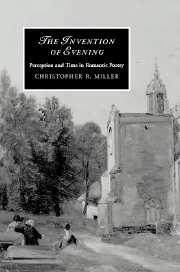Book contents
- Frontmatter
- Contents
- Acknowledgements
- Introduction
- 1 The pre-history of Romantic time
- 2 Coleridge's lyric “moment”
- 3 Wordsworth's evening voluntaries
- 4 Shelley's “woven hymns of night and day”
- 5 Keats and the “Luxury of twilight”
- 6 Later inventions
- Notes
- Bibliography
- Index
- CAMBRIDGE STUDIES IN ROMANTICISM
4 - Shelley's “woven hymns of night and day”
Published online by Cambridge University Press: 04 May 2010
- Frontmatter
- Contents
- Acknowledgements
- Introduction
- 1 The pre-history of Romantic time
- 2 Coleridge's lyric “moment”
- 3 Wordsworth's evening voluntaries
- 4 Shelley's “woven hymns of night and day”
- 5 Keats and the “Luxury of twilight”
- 6 Later inventions
- Notes
- Bibliography
- Index
- CAMBRIDGE STUDIES IN ROMANTICISM
Summary
Yeats once suggested that among Shelley's symbols, the most important were the Morning Star and Evening Star – the planet Venus in its dual guises. As Phosphor and Hesperus, this “star” betokened celestial persistence and cyclical rebirth; and in its brightness and primacy in the night sky, it signified love, beauty, liberty, desire, and wisdom. According to Yeats, it expressed “that Intellectual Beauty which was to Shelley's mind the central power of the world.” True enough, and yet the star is never actually mentioned in the “Hymn to Intellectual Beauty.” Rather, evening itself, not its celestial attribute, appears in the poem, twice; and it figures prominently in Shelley's poetry, as both symbol and setting, abstract metaphor and sensuous experience.
Shelley inherited the chronotope of evening from the pastoral idiom of Virgil (whose tenth eclogue he translated) and its permutations in Milton, Collins, Gray, Coleridge, and Wordsworth; and in the process, he translated it into his own symbolic vocabulary. He did not do so all at once, of course. An early unpublished poem called “The Sunset” can be read as an allegory of coming late to this poetic tradition: it tells the story of a frail youth who dies in his sleep, a few hours after remarking to his lover that he has missed seeing the sunset. While the youth misses something that happens every day, the ambitious poet faces the challenge of describing an event that has already been profusely appreciated in verse.
- Type
- Chapter
- Information
- The Invention of EveningPerception and Time in Romantic Poetry, pp. 112 - 144Publisher: Cambridge University PressPrint publication year: 2006



